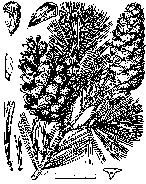
Pinus morrisonicola Hayata (3).
Common Names
Taiwan white pine; Taiwan shortleaf pine (4); Thông Pà cò (Vietnamese) (5).Taxonomic notes
Syn: P. kwangtungensis Chun & Tsiang (1); P. formosana Hayata 1908; P. uyematsui Hayata 1913; P. parviflora sensu Matsum. & Hayata 1906 non Sieb. & Zucc.; P. parviflora Sieb. & Zucc. var. morrisonicola (Hayata) Wu 1956 (3).Description
"A large tree, up to 15-25 m high and 120 cm in diameter, the trunk often crooked. ... Leaves 5 in a fascicle, 8 cm long, triangular in cross section, with 2 resin ducts. Mature cones ovoid to oblong-ovoid, up to 10 cm long, 4-5 cm in diameter; cone scales oblong-ovoid, the apex rounded. Seeds winged, about 2 cm long including the wing" (3)."Trunk bark grayish brown to blackish brown, irregularly shallowly fissured or shallowly cracked, scaly, scales with tiered layers (the bark of young stems grayish brown, smooth); lenticels inconspicuous; outer bark about 6 mm. thick, hard and brittle, lignified corky, with a tiered, red brown cross section; newly formed periderm almost inconspicuous, milky white; inner bark 0.5-1.5 cm. thick, pale reddish white, finely fibrous, gradually becoming pale yellowish brown and gumming colorless transparent resin after cutting; cambium and newly formed phloem almost inconspicuous, white. Freshly cut sapwood pale yellowish white, wood rays inconspicuous, resinous" (4).
Range
Taiwan, S China and N Vietnam. In Taiwan, found "[a]t altitudes of 300-2,300 meters throughout the island, usually scattered and in association with broad-leaved trees, now scarce at lower elevations and mostly present at higher elevations and less accessible places" (3). In Vietnam, found in Hoa Binh (Pa Co commune, Mai Chau district) and Cao Bang (Duc Hong commune, Trung Khanh district), where it is found on limestone peaks at elevations of about 1,300-1500 m. It grows in pur stands, or mixed with Fokienia hodginsii and some species of Fagaceae and Lauraceae (5).Big Tree
Oldest
Dendrochronology
Ethnobotany
"Timber used by local people as good construction timber. Besides its oleo resin can be used as an adhesive. This is a very endangered tree species of Vietnam. Due to its confined habitats, the number of individuals is not many, and the needs in construction timber and fuelwood of the tribesmen groups may cause the species to disappear; its number being strongly reduced. Rated as a vulnerable species. We need integral protection of the species in-situ (at the existing pine groves of Pa Co). Research should also be made to create plantations of the species at its range of habitats, as supplementary measures for preservation" (5).Observations
Not seen. Taroko National Park looks like an interesting place to see it. Some detailed location data from Taiwan (2) follows:Hualien Xian: Xiulin Xiang: Taroko National Park, Chingshuishan. At Peak of Chingshuishan, a metamorphosed limestone mountain. Elevation:2200-2400 m. 121:38:21E, 24:14:41N. A tree ca. 4-5 m tall, common.
Nantou Xian: Jenai Xiang: National Chung Xing University Hui-Sun Experimental Forest. Along the forest road to Tang- kungpei; mixed coniferous-broadleaf forest. Elevation: 600-800 m. 121°2'17"E, 24°5'20"N. On exposed stone wall by forest road. Small tree ca. 2.5 m tall; DBH ca. 3 cm; immature fruits green.
Taitung Xian: Haitung District between Xiangyang and Liyuan. Elevation: 1900 m.
Remarks
Listed as threatened in Vietnam by the World Conservation Monitoring Centre.Citations
(1) Silba 1986.(2) Botanical Inventory Of Taiwan.
(3) Li 1975.
(4) Liu 1970.
(5) Forest Inventory and Planning Institute 1996 (as P. kwangtungensis).
[Pinus] [Pinaceae] [home]
This page is from the Gymnosperm Database
URL: http://www.geocities.com/RainForest/Canopy/2285/pi/pin/morrisonicola.htm
Edited by Christopher J. Earle
E-mail:earlecj@earthlink.net
Last modified on 2-Jan-99